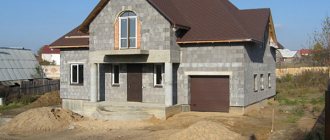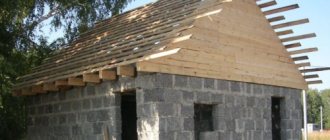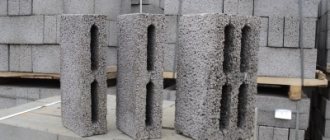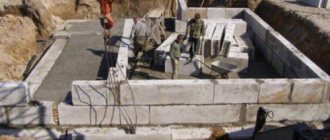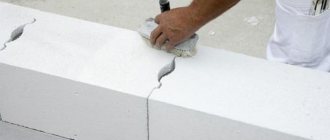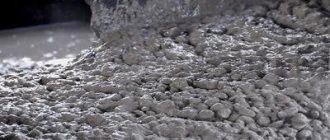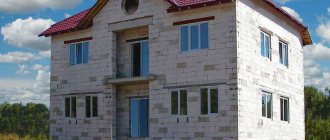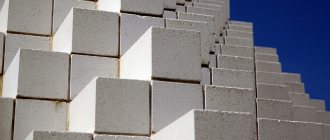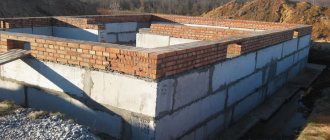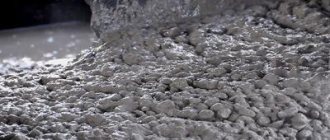Laying expanded clay concrete blocks can be done by hand. In this case, it is important to follow the basic rules, since violation of the step-by-step instructions during installation will shorten the service life of the object. Expanded clay concrete products have many advantages: they are characterized by low thermal conductivity, resistance to low temperatures, and they do not absorb moisture. If the masonry is done correctly, the material will retain these properties throughout its entire service life.
Expanded clay concrete blocks.
Content
Sometimes builders wish each other “soft walls” - without malicious intent and purely as a joke. But weak structures can really infuriate even seasoned installers, not to mention home craftsmen. With a lack of experience, not only the “sandy” heterogeneous walls of old Soviet houses become problematic, but also modern building materials, such as plasterboard, hollow brick, cellular concrete and the like. In this article we will talk about choosing the right fasteners, the principles of reliable fastening in weak foundations, and share proven life hacks.
Features of fasteners for concrete walls
A dowel for concrete is different from a brick one. Therefore, in order to avoid mistakes when installing it, you need to become familiar with its features.
In practice, it is not very rational to use concrete dowels on brickwork, especially if the wall is made of hollow material. In this case, fasteners of a special design and installation specifications are used.
The differences between the dowel for concrete and the option for brick are presented in the table:
This is a metal or plastic bushing, the design of which has a double thrust mechanism. This guarantees the strength of the fastening - in any case, one of the spacers hits and is fixed on a solid base.
Types of dowels for concrete
There is a fairly large number of fasteners for concrete, the most famous and effective of them are presented in the table:
| Dowel type and photo | Peculiarities |
| Spacer | This type of dowel for a concrete wall differs from other types in the size and shape of the screws. They are usually made in a slate shape, allowing the pieces to be driven into the concrete wall with a hammer. Sleeves or fasteners of cylindrical or tubular shape can be varied: with two or three spacers. They often have spikes, which increases the reliability of fixation. |
| Butterfly | These types of concrete dowels are used when working with thin wall coverings. The sleeve is inserted into the hole, and its back side is folded due to the insertion of the screw into the concrete wall. This is how the dowel is fixed to the wall. |
| This fastener is similar to the spacer type; the fixation is made using the “butterfly” type. Its peculiarity is the ability to use it for a wide variety of wall surfaces. |
| Fasteners are used for mounting structures to concrete made of different materials. The nail is driven into the wall with a hammer, but it is better if you use a special gun. |
| The façade tool is used for constructing frame structures on a brick and concrete base. Dowels share some of the same characteristics as the expansion type, but are slightly longer and have a larger head. The rod and sleeve are made of impact-resistant materials. |
| This is not an ordinary fastener. It contains a special capsule that contains chemicals, so the screw is made of metal. A dowel is used for lightweight concrete. When screwing in the element, the chemicals act as glue, so you need to wait until the base hardens. This usually lasts from two hours to a day. |
| Works only for aerated concrete surfaces. A special feature of this type is the wide thread, which guarantees strength when using similar dowels for porous surfaces. |
| This fastening is used for wall blocks made of polystyrene concrete. Its sleeve resembles a spacer sleeve, but has a spiral appearance. The GB type dowel can withstand quite heavy loads. They can be effectively used for attaching hanging cabinets, hoods, shelves and other heavy household items. |
Self-tapping screw in concrete without dowel
Dowel for expanded clay concrete blocks
Dowel for concrete l=60 with a diameter of 10 mm
Mounting methods
It is considered optimal to mount this material flush with the inner surface of the walls of the house. It is strictly not recommended to lay the Mauerlat on the house closer than 5-6 cm from the outer plane of the walls.
Scheme of fastening the Mauerlat to the armored belt.
- The Mauerlat must be attached to the wall of the building. In this case, it is recommended to make a protective fence for the Mauerlat outside, preferably from brickwork. We should not forget about waterproofing, it is necessary to protect the wood. You shouldn’t overdo it, two layers of roofing material will be enough.
- There are several ways to directly attach a structure such as a Mauerlat to a house. If the walls are brick, wooden blocks are built into the masonry several (2-3) rows below the top row of the wall.
- It is to these bars that the Mauerlat will subsequently be fastened using staples. When constructing roofs for houses built from expanded clay concrete or foam concrete or gas silicate blocks, a reinforced concrete belt should be made under the roof.
- When pouring this belt, it is necessary to insert threaded rods into it. After this, holes are drilled in the Mauerlat beams for these studs and beams are installed directly on them, which are pulled to the walls of the house with nuts and washers.
The most common are studs with a diameter of 1 2 – 1 6 mm. They must be installed at least every 1.6-2 m.
There is also fastening of the Mauerlat to the house using studs, intended for brick walls. So, during the construction of walls, studs are embedded in the brickwork so that the depth is at least 3 rows of bricks.
Mauerlat laying diagram.
To save money, instead of studs, it is recommended to embed simple reinforcement, welding nuts to it by welding. In the same row of brickwork where the studs (reinforcement) are embedded into the house, it is necessary to insert thick (3-6 mm) steel wire, the ends of which must be of sufficient length to tie the Mauerlat.
Note that often during the installation of a structure such as a Mauerlat, it becomes necessary to splice the beams together. This is done by cutting the beams into half a tree, and then fastening them with bolts or nails.
- One of the most popular recently is the fastening of the Mauerlat, which uses exclusively edged boards measuring 50x150 mm (usually up to 60 x 160 mm).
- Initially, you need to lay out one row of boards on the walls, and then secure them to the house using anchor screws (not bolts, since their heads will protrude). The length of the anchors must be at least 20 cm.
- Holes in a reinforced concrete belt or brickwork are made using a hammer drill, having first drilled the board with a regular drill. Then you need to lay out the next row of boards on the house, nailing them to the first row using simple 100 mm nails.
- The joints of the boards should be made in other places, thus performing the dressing. In the corners, the boards also need to be laid with a bandage. The result will be a Mauerlat with a thickness of 100 mm, which is quite enough.
This method of attaching a mauerlat to a house, especially to expanded clay concrete blocks, is popular for several reasons. First of all, it is much easier to lift boards to a height than bars. The next reason is that there is no need to cut half a tree.
Dowel selection
When purchasing various objects to attach to a concrete wall, you should choose the right dowel for concrete; its approximate dimensions can be selected from the table:
Table for determining the dimensions of a fastener depending on the type of load on it
Fasteners are selected depending on the type of place where they will be used.
Before driving a dowel into a concrete wall, the future load must be taken into account:
- To secure structures of large mass, for example, wall bars or wall-mounted exercise machines, it is best to use dowels with a mounting depth of at least 85 mm;
- When fixing horizontally into a concrete wall, it is recommended to purchase fastening elements in which the fastening depth is at least 30 mm, and the diameter of the dowel on the outside is 7 - 11 mm;
- For the installation of a suspended ceiling, lamps, where the main load is located below, fasteners should be selected with spacer antennae and transverse notches;
- When selecting dowels for an already drilled hole, it is important that the parameters of the fastener and the diameter of the hole match each other. In this case, the dowel for expanded clay concrete or other material must have a diameter no less than the size of the hole;
- When using mounting fasteners, in order to prevent the destruction of weak walls, the dowel should serve as a softening pad. In this case, the fastener fits quite tightly to the fastener, and the load is distributed evenly throughout the product.
Features of installing dowels in the wall
Technology for installing dowels in a concrete wall
To do the work yourself you need to purchase:
- Electric drill;
- Pobedit drill;
- Sharp nail;
- Dowel of the desired design;
- Electrical tape;
- Small hammer.
After preparing all the tools, you can begin installing the dowels.
Work instructions:
- Mark the installation location of the fasteners with a ballpoint pen or a simple pencil;
- A small indentation is made with a nail, hacksaw or pin. This will allow you to correctly align the drill when making a hole;
Tip: The diameter of the fastener must match the size of the hole and screw. In this case, the dowels should fit into the holes with little effort. Otherwise, the fasteners will dangle or move to the side. It is imperative to choose the correct dowel length in accordance with the length of the self-tapping screw used.
- If the number of dowels was calculated incorrectly, you can make the product yourself. To do this, take wooden blocks of the required length. They are given a rounded cross-section, thickening at the top and decreasing in diameter at the bottom. After this, screw the screws into the concrete without a dowel;
- A drill of the required diameter is inserted into an electric drill;
Tip: Make a mark on the drill that will correspond to the depth of the hole. The mark is placed at a distance slightly greater than the length of the dowel. To do this, the fastening element is applied to the drill, and electrical tape is wound around it in the right place; it will mark the boundary of the drilling depth of the hole.
- The drill is placed in the previously made recess. The drill is positioned strictly perpendicular to the surface;
- The resulting dust and cement chips are removed from the drilled hole. This can be done using a vacuum cleaner;
- The dowel is carefully inserted and hammered in with a hammer, but not too hard, until it stops;
- A screw is screwed into the dowel if it is included in the structure.
Tip: In everyday life, you should use dowel-nails made of polypropylene or nylon. They can withstand loads of up to 75 kg, which depends on the size of the fastener. Steel products are used most often in industrial facilities.
To correctly hammer a dowel into a wall, you should watch the video in this article.
Installing a spring dowel
Difficulties and mistakes
Laying walls yourself is never without problems. But if you foresee possible difficulties in advance, you can facilitate the construction process and avoid gross violations in the masonry.
Typical mistakes that should not be made:
- Installation of low-quality products. Products must be certified, and the composition cannot contain any low-quality additives or slag impurities. Manufacturers that respect themselves and their reputation add only clean, sifted quarry sand, clean water, high-grade cement and good quality expanded clay.
Therefore, when buying a product from unknown companies or not paying attention to its accompanying documents, you can run into an outright fake.
- Use of defective products. The blocks should not have chips, damage or gouges that would affect its structural integrity and durability. If a block has such damage and does not crumble in your hands, this does not mean that it will remain intact in the wall. The load can simply crack the product and lead to the destruction of an entire section of the wall.
- Splitting blocks with a pick or hammer. The blocks must be carefully cut with a grinder or a special hacksaw, but not beaten off. Firstly, there is no guarantee that the required piece will be cut off using this method. And secondly, you can hit too many, and as a result such a block cannot be used anywhere. And this is already an overconsumption of material.
- Purchase of blocks with low density. To build a residential building with one floor or a garage, it is enough to take blocks with a density of D. But for more elevated and serious buildings, the density should be even higher - at least D800 (800 kg/m 3 ).
- Using reinforced concrete slabs as an armored belt. This material is too heavy for expanded clay concrete. The role of the armored belt is to help the walls evenly distribute the load from the floor beams and roof, and not to give them an even greater load from the weight of the armored belt.
Anchors for aerated concrete and gas silicate blocks
As mentioned above, the anchor is an independent element. As a rule, it consists of a hollow tube and a pin inserted into it.
After the nut is tightened, the anchor is securely fixed in the aerated concrete. The anchor can only be pulled out with part of the aerated concrete block
If you were unable to find dowels and anchors intended for aerated concrete in stores, then you can buy ordinary dowels, but not with two longitudinal slots, but with four. In this situation, when the screw is tightened, the dowel is deformed (twisted) in such a way that coupling ribs are formed (see video).
Advantages and disadvantages of masonry
Such blocks have few disadvantages. The building material is hygroscopic, so before performing thermal insulation and finishing work, the structure must be protected from moisture. In addition, the material is quite fragile and is destroyed by a single point impact, so care should be taken during transportation.
Masonry methods
The main criterion when choosing the most suitable option is the thickness of the walls of the structure that is planned to be erected. Masonry methods:
- To speed up the work, use products whose width will be equal to the thickness of the supporting structure. To improve the properties of the building, it is protected from the inside with a plaster compound, and thermal insulation is performed on the outside; this option for constructing walls is more suitable for a garage or warehouse.
- To improve the thermal insulation properties of the box, walls are erected, the thickness of which corresponds to the length of expanded clay concrete products; in addition, a plaster composition and thermal insulation material are used. The layer of the last coating may be smaller than in the case when the first of the considered masonry methods is used; this option is suitable for the construction of small objects (bathhouse, sauna).
- Installation of expanded clay concrete products with bandaging is carried out, leaving gaps in which thermal insulation material will then be laid. The recommended thickness of vertical box structures is 60 cm.
- 2 walls are erected with an air gap between them. This option is more preferable, because when masonry is done using this method, heat loss is significantly reduced and the cost of insulation is reduced. Its thickness may be minimal, but the costs of building materials increase: 2 times more expanded clay concrete blocks are used for masonry.
There are several options for improving double masonry using the latest technology described: the structure is strengthened with reinforcement, and additional insulation is laid between the walls.
Calculation of cement mortar
Conventional cement-sand mortar (CSM) is usually used as the main binder for laying expanded clay concrete blocks. It is purchased in the form of a dry mixture or made from sand and cement at the construction site. The finished mixture is a little more expensive, but at the same time the components are already mixed in the required proportion, which eliminates errors and some preliminary steps.
An important factor affecting consumption is the geometry of the block. If the products have significant deviations (more than 1 mm), then the masonry joint must be made thicker. Thickening of the masonry joint leads to a decrease in the strength of the entire masonry. The optimal seam for expanded clay blocks with relatively good geometry should be 5 – 10 mm.
Expanded clay blocks are not suitable for masonry with thin joints. It is also not recommended to lay them on mineral adhesives.
It is believed that the approximate consumption of mortar per 1 cubic meter of masonry is 40 kg with a 10 mm seam, but this parameter can vary greatly depending on the experience of the mason and the quality of the material.
Self-preparation of masonry mixture
The grade of masonry mortar should not exceed the grade of blocks by more than twice. For M50 expanded clay blocks, it is recommended to use a solution no larger than M100. This parameter can be adjusted by the ratio of sand and cement.
Cement M500 in a ratio of 1 to 4 with sand will give a solution of M100, M400 - M75.
- To prepare the mixture, you will need a concrete mixer, since in manual mode the process will take too much time.
- The sand must first be sifted to remove stones and inclusions of large fractions.
- Half a bucket of water is poured into a concrete mixer and a plasticizing compound is added to increase the elasticity of the solution.
To save money, builders often use liquid soap or detergents, but such homemade plasticizers significantly reduce the quality of the mixture.
- Add half the sand and cement to the water, continuing to mix.
- Add the rest of the mixture and add water. Stir until a thick, creamy mass is obtained.
- The solution should be used before it starts to harden.
Features of masonry of door and window openings
The use of wall material is not limited to barns, so you need to figure out how to lay the material in door and window openings. There is no magic device and it is better to rely on your own experience.
A friend's hand will also help, but it all starts with the markings. To process the block, you will need a file. The first row is laid up to the joint, and so on until the very top. Then it is important to set the partition level. Otherwise it is called a crossbar. The scheme involves making significant indentations on the sides of more than 30 cm. This is necessary so that the wall does not place a large load on the partition.
Windows can be a little trickier. It all depends on the design, since there are straight and arched options.
Jumpers are made from materials:
- steel;
- tree;
- reinforced concrete.
A steel channel is the best profile for expanded clay concrete. Markings are made in the upper part, and then supports are installed. The difficulty is that the material will have to be processed. It is important to hide the side parts of the channel so that they do not stand out on the wall. When the level is checked, all that remains is to fix the jumper. A standard window 1.2 meters wide is mounted on three screws.
The reinforced concrete opening is installed using a similar technology. The advantages include high strength and durability. This option is suitable when the window opening is more than 1.2 meters wide. Such a block can withstand a load of more than 100 kg.
Fastening external finishing elements
| Types of fasteners | Block name Porotherm | Design load, kg |
| Mungo MBK 10×120 | Porotherm 25 | 25 |
| EJOT SDP KB 10S*80V | Porotherm 25 | 25 |
| Thermoclip Wall V2 10×100 | Porotherm 38, 44, 51 | 25 |
| Mungo MQL 10×100 | Porotherm 38, 44, 51 | 25 |
| EJOT SDP KB 10S*80V | Porotherm 20 | 70 |
| Thermoclip Wall V2 10×100 | Porotherm 20 | 50 |
Chimney block
Chimney blocks: advantages, installation
Classic ceramic pipes, despite a wide range of applications in construction, require increased attention, given their sufficient fragility in external structural structures. Therefore, expanded clay blocks are often used for chimneys. They protect the main pipe not only from mechanical damage, but also from temperature changes, which especially often occur during the winter period of operation of the stove chimney. Next, we will consider the main varieties, as well as what such structures are made of and how safe and effective they are in terms of long-term operation of chimneys.
Scope of application of ceramic blocks
A chimney or channel made of expanded clay concrete blocks is often used in private construction, but you can also find many examples of the use of such structural forms, also in industry. Ventilation ducts for chimneys have the following list of advantages:
- Relatively light weight.
- Excellent thermal insulation properties.
- Excellent strength, with concrete from M100.
- The presence of special small pores on the outer sides, which improve the fastening of finishing agents.
Installation of chimney blocks
Expanded clay concrete blocks require quite careful and painstaking work during construction. It is necessary to strictly observe all the rules, as well as the standards established during installation. When carrying out the installation, take into account important points during work, which will be discussed in more detail later - this is like the masonry system, as well as the possibility of using a foundation.
Foundation for a chimney, is it necessary?
Even despite the fact that the weight of the structural elements is quite small, a foundation will be needed in any case. To do this, you need to use a concrete solution, to which crushed stone must be added, only of a small fraction. In addition, to increase strength, you need to use “reinforcement”. So, working conditions:
- The diameter of the reinforcement is at least 10 mm.
- The mixture is in the proportion of 1/4/6, in order cement, sand, crushed stone.
- The “pillow” must correspond strictly to the level.
- The base must “stand” for at least two weeks.
How to lay out ceramic blocks correctly?
To install the blocks correctly, you will need to first choose the right solution and follow some basics. So:
- Use a mixture that is resistant to acids, also do not forget about the minimum layer of solution, it should not exceed 1 cm. In case of a larger size, so-called cold bridges may form.
- Blocks are placed on the “cushion”, which are subsequently completely filled with solution.
- First you need to lay two or three rows and only then insert the pipe, simultaneously installing thermal insulation and reinforcement.
- If the design provides for maintenance hatches, we make slits in them.
- To generally strengthen the structure, you need to insert reinforcement in the corners. By the way, there are special holes for this purpose.
- Do not forget that the pipe is inserted only from the bottom up, and all seams are coated with sealant, also with an anti-acid composition for ceramic structures.
Thermal insulation between pipe and block
Thermal insulation between the pipe and the block is required if the chimney is connected to a solid fuel boiler. Several basic requirements must be applied to the insulation:
- Thickness ranges from 10-25 mm.
- Fire resistant properties.
- Moisture resistant.
- High density.
Thermal insulation between pipe and block
Mineral wool is most suitable for these purposes. Fastening is done using plastic clamps. In addition, do not forget that there should be free space for ventilation.
Surface finishing of expanded clay blocks
Of course, the surfaces of expanded clay blocks need to be treated against external influences. Tile and plaster are most suitable for these purposes.
- Plaster should only be used in a format that is resistant to precipitation and temperature changes.
2. The requirements for tiles are the same; they must be fire-resistant and frost-resistant. Installation should be done using special glue.
Methods and technology for laying blocks of expanded clay concrete
In order to make a wall from expanded clay concrete blocks with your own hands, you will need the following masonry equipment:
- Rubber hammer for the process of adding blocks;
- Roulette, construction level;
- Trowel with a rectangular platform;
- Cord-mooring;
- Construction square for measuring blocks if cutting is necessary;
- Plumb;
- Grinder for gating;
- Shovels, concrete mixer;
- Scaffolding and buckets.
So what is more profitable to use?
Understanding the financial component, we can draw some conclusions. The price of glue is higher than the cost of cement, but both methods allow you to get a strong and reliable wall. But if you consider that when using cement mortar, finishing of the walls will subsequently be required, then the cost per square meter will increase significantly in price. The benefit is obvious - using glue is more expedient and will ultimately help you save money.
produces and sells expanded clay concrete blocks and standard adhesive for blocks based on aerated concrete on favorable terms. Delivery in any volumes.
